Equilateral Pentagons
Equilateral Pentagons E5 are polygons with five sides of equal length. There are an infinite number of distinct E5 since the internal angles can take practically any real value. Next java applet shows some familiar geometric shapes disected into E5s. Where the disection is not unique, an animation shows some possibilities. A selector permits to switch between all the figures.
|
Java source code: StickPoint.java and SticksApplet.java |
Theory
Only four intersected equal circles are enough to define a E5. The center of each circle corresponds to one vertex of E5 namely angles e, a, b and c. The fifth vertex d is determined by the intersection of circles C1 and C4 which gives the smaller angle.

E5 = F(a, b)
Conditions for Simplification
In order to avoid reflections, translations, rotations (and complications) of a given E5 two conditions can be stated:- d must be the smaller of the five angles.
(d <= a) && (d <= b) && (d <= c) && (d <= e) - a must be greater or equal than b.
a >= b

Covex and Concave E5
The angle c's values determine the convexity of E5. We can conclude that:- E5 is CONVEX if angle c is lower than 180o.
- E5 is CONCAVE if angle c is greater than 180o.
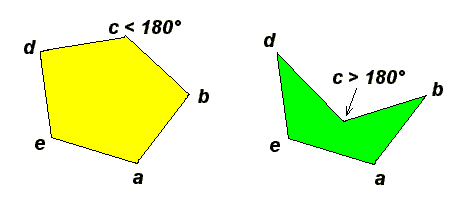
Self-Intersecting for E5
The angles a and b values determine the self-intersecting of E5. We can conclude that:- E5 is not self-intersected if:
2a + b is greater than 180o. - E5 is self-intersected if:
2a + b is lower than 180o.
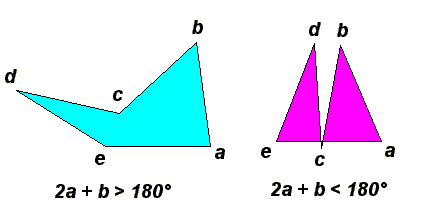
Some Trigonometry of E5
To find the values of angles c, d and e as functions of (a, b) some calculations and the following figure can help:
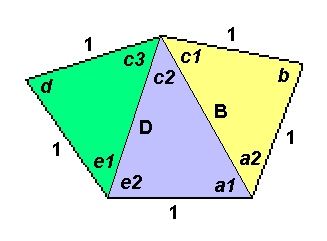
a = a1 + a2
c = c1 + c2 + c4
e = e1 + e2
a2 = c1 = p/2 - b/2
a1 = a - p/2 + b/2
B = 2 * sin(b/2)
D2 = 1 + B2 - (2)(1)(B) * cos(a + b/2 - p/2)
orD2 = 1 + 4*sin2(b/2) - 4*sin(b/2)*sin(a + b/2)
Now, having D, the angle d value can be calculated from green triangle:
| d = cos-1 [ cos(a) + cos(b) - cos(a + b) - 1/2 ] |
| e = tan-1 [ |
|
] + 1/2 * (p - d) |
| c = (5/2)*p - a - b - d - e |
Minimums and Maximums of the angles
Having three angles c, d and e as functions of other two (a,b), I have drawn a lot of beatiful families of curves, they are still drawn on real paper. I hope soon have time to include them here as electronic media... Also, other information such as area, angles' relations can be plotted too... Analysing angles plots we get some results: For No-self-intersected E5 these are the ranges for the angles:
| Minumum | Maximum | |
| a | 60o | 120o |
| b | 28.9o | 108o |
| c | 108o | 331o |
| d | 0o | 108o |
| e | 75.5o | 240o |
Equilateral Polygons' To-Do
There is a lot of material (original to be included, and not original to be mentioned) next to be added as time permits...-
An applet for drawing the plots of functions F(a, b).
-
From the 14 know
convex pentagons tesselations
of the plane, some has equilateral pentagons...
There are also some tesselations with more than one type of and/or concaves equilateral pentagons. -
Polyominoes are in fact equilateral polygons (The pentominoes are
equilateral dodecagons E12). These dodecagons have only few internal
angles values: 0o, 90o, 180o, 270o and
360o. These discrete angles surely simplifyes in some way the families
of equilateral polygons.
-
A Math verse reads ...every conic curve can be determined by 5 points...
Therefore exits a conic curve touching the 5 vertices of every E5.
I'm writing a Java applet for drawing conics touching all the general
E5 vertices. The relations between conic's and E5's
parameters should be interesting.
-
I made some calculations for equilateral hexagons (though complicated).
Three angles are needed for the hexagons. While E5 needs surface plots,
E6 needs three-dimensional plots. Altough, more conditions can be
imposed to the angles to get a reduced set. For instance, families of symmetric
equilateral hexagons having their angles values of the form
2p / n, being n an integer, tile the plane chaotically.
-
Determine minimum solutions for dissections of EMs into
ENs. wheter M > N, M = N, M < N.
There are systematic solutions by software?
Chaotic Tiling with Equilateral Polygons
-
The rhombi are equilateral tetragons or E4. Only one angle is needed
for their description. Exists one pair of rhombi for chaotic tesselation. Also
exist one triplet of rhombi for chaotic tesselation, and one quartet, one quintet
and so on...
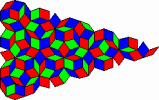 Penrose tiling figure taken from an internet site
Penrose tiling figure taken from an internet site
-
The CHAOS TYLES
are two equilateral pentagons
Their angles are
(80o, 160o, 60o, 140o, 100o)
and
(40o, 200o, 60o, 100o, 140o).
Applying the notation mentioned above we have this tiles are
E5(100o, 80o)
and
E5(100o, 60o).
-
Two symmetric equilateral hexagons I found in 1997 by drawing regular decagons,
seems can tile chaotically the plane. Their shapes recall us the main two types
of optics lenses:
- Convex with angles (72o, 144o, 144o, 72o, 144o, and 144o)
- Concave with angles (72o, 72o, 216o, 72o, 72o, and 216o)
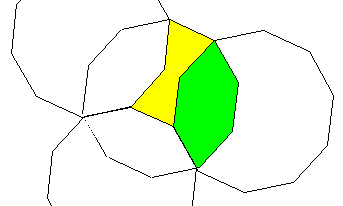
- Open questions:
- There exists three E5 for doing chaotic tiling, four? more?
- There exists 2, 3, 4, ... En (yes, n) for doing chaotic tiling?
Jorge Luis Mireles Jasso
Torre�n, Coah. M�xico.
April 4, 2002
Also in this site: